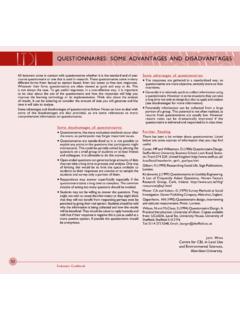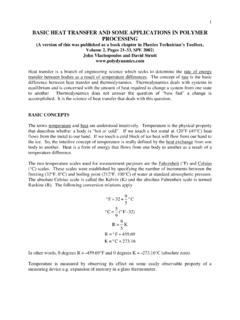Transcription of SUGI 23: Match-Merging: 20 Some Traps and How …
1 match - merging : 20 some traps and How to Avoid ThemMalachy J. Foley University of North Carolina at Chapel Hill, NCABSTRACT match - merging is a common form of combining files. Yet, it has itspitfalls. This tutorial examines more than 20 Traps that can snarl even aseasoned programmer, and provides proven strategies for avoiding these The little old match -merge is a complicated thing indeed. How complicated?Well in 1997, Foley (see REFERENCES) identified a dozen Traps associated withmatch-merge. Amazingly, that was just the beginning. This paper identifies and examines another fifteen ways match -merge canambush a programmer. It summarizes all 28 pitfalls outlined in the two papersand explores defensive strategies to avoid all of them.
2 Among other strategies, a beta version of a SAS macro is presented to catchtraps. This macro, when used with the SAS log, will detect or sidestep 88% ofthe Traps . You can use this macro even if you are unfamiliar with macro code. This article is for anyone who uses the SAS BASE product and studying it, you should know what most of the match -merge pitfalls are andhow to defend yourself against CODE COMPLEXITY The first trap to explore is the complexity of the SAS code used for match - merging . It is deceivingly simple. For example, look at the code for theclassic match -merge. Exhibit 1: Classic 4-statement match -Merge ---------------- DATA ONE TWO; MERGE ONE TWO; BY ID; RUN; ---------------- This code could hardly be simpler or more compact.
3 The pitfall is that thecode's utter simplicity lulls the user into thinking nothing can go , the user drops his or her guard, and that is when things start togo wrong. These four seemingly innocent lines of code have burnt more thantheir share of SAS programmers, often TutorialsAdvanced Tutorials28 Traps So, what specifically can go wrong with a simple match -merge. The followingtable lists twenty-eight (28) ways a match -merge can go awry. SAS provides anote, warning, or error message for some of these situations. However, for mostof the Traps listed, no messages are produced. In these cases, it is totally upto the programmer to be aware of the Traps and to catch them before they producea faulty merge.
4 TABLE 1: List of Traps -------------------------------------- By variable Traps - Type mismatch Pre ERR - Missing By statement Pre - Justification mismatch Pre - Ambiguous By variables Pre - Length mismatch Pre - Value instability Pre - Manipulation History Pre - BY var not in file New ERR - Different case BY value New - Missing By values New Statement-related Traps - Missing DATA statement New ERR - Missing MERGE statement New ERR - Missing RUN statement New - empty DATA statement New - empty MERGE statement
5 New - empty BY statement New - MERGE state. with 1 DS New - Incomplete BY statement New Other Traps - Testifying simple code P/N - Automatic retain P/N - Overlapping variables P/N INF - Fractional BY values Pre - Many-to-many/few merge Pre NTE - Calculations in Merge Pre - IF in Merge Data Step New - WHERE on input vars New - Input Files must exist New ERR - Input files not sorted P/N ERR ------------------------------------- In the previous SUGI paper by Foley, some of the Traps listed in the abovetable were identified and discussed at length.
6 These Traps are tagged "Pre"(for Previous) in Table 1. Experienced SAS programmers actually fall into TutorialsAdvanced Tutorials This paper picks up where the other paper left off. It analyzes theremaining pitfalls in Table 1. These Traps are labeled "New". This paper alsoprovides an array of defensive strategies that programmers can apply to avoidmost of the Traps . Situations that are detected by SAS are marked as NTE, ERR and INF whichcorrespond to NOTE, ERROR and INFO messages. The INFO message is produced bySAS only if the "OPTIONS msglevel=i" statement is VARIABLE Traps The first part of Table 1 shows 10 Traps associated with BY variables. A BYvariable is one of the variables listed in a BY statement.
7 The SUGI 22 papergives a comprehensive treatment of most of these Traps . The next two sectionsof this paper examine the two BY variable Traps not discussed in the previouspaper. DIFFERENT CASE BY VARIABLE VALUES It happens more often than you would like. You are trying to merge twofiles and the BY variables, which are character variables, should be all onecase (upper or lower) and they are not. Usually one input file has all of itsBY variable values (the value assigned to a BY variable) in upper-case lettersand the other file has its BY variable values in lower-case letters. The SAS match -merge is case sensitive. For instance, an upper-case letter"A" will not match with a lower-case "a".
8 This is as it should be. A lower-case letter is not the same as an upper-case letter. Yet, often when youreceive data from different sources, the alphabet is not keyed uniformly inupper or lower case. Here is an example of this trap. Exhibit 2: Ex. of BY Value Case Mismatch ---------------- DATA ONE TWO MERGE ONE TWO; BY ID; RUN ---------------- --------- ----------- ------------------ FILE ONE FILE TWO FILE ONE TWO --------- ----------- ------------------ ID NAME ID AGE SEX ID NAME AGE SEX --------- ----------- ------------------ A01 SUE a01 58 F A01 SUE.
9 A02 TOM a02 20 M A02 TOM . A05 KAY a04 47 F A05 KAY . A10 JIM a10 11 M A10 JIM . a01 58 F a02 20 M a04 47 F a10 11 MAdvanced TutorialsAdvanced Tutorials NOTE: The data set ONE TWO has 8 observations and 4 variables. In this example, there are two input files called ONE and TWO. These filesare combined using the classic 4-statement merge. Notice how none of therecords matched in the output file, ONE TWO. The SAS log file shows no problemsexcept for the NOTE (see above) which indicates that there are 8 observations inthe output DIf_case.
10 * for information - Maybe want to write sections on symptoms that you see and what they can mean, for example no match symptom can mean just /dif - Is BOTH the best way to describe this union of files? - OR you can get nothing see EX 2 in DIF_CASE??? -figure out what this meansIF you have time later on. One way to detect a case mismatch problem (as well as the justificationmismatch described in the SUGI 22 paper) is to check the SAS log for theobservation count. If the number of observations in the output file is equal tothe sum of the observations in the two input files, then none of the recordsmatched. Another way to detect these mismatches is to add the following code afterthe merge DATA step.














